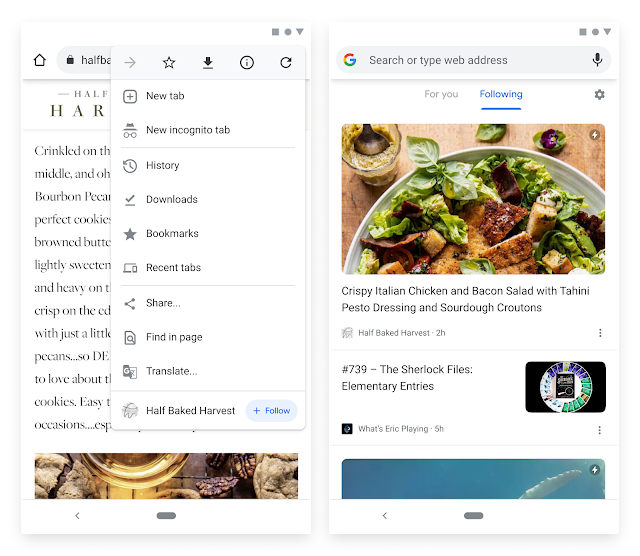Google Aims to “Revitalize RSS” and Recapture Users’ Trust with Experimental Follow Button in Chrome
관련 글: 배민 레전드 막나가는 횟집
The internet was set abuzz yesterday after Google officially confirmed that it has been testing a Follow button for websites in Chrome. In February, the publishers of Chrome Story spotted the button on Canary for Android, and speculated that it may be integrated with Google’s Discover feature. Chrome announced that it is building on RSS to allow users to follow websites. The latest content from these sites will show up chronologically on the New Tab page as it is published.

At this time it does not look like Follow would be integrated with Discover, which is focused on surfacing content based on user-selected topics and a user’s search activity. The Follow feature appears that it will function almost like a bare bones “Chrome Reader,” if you will.
In 2013, Google blithely closed down its Google Reader product in a post titled “A second spring of cleaning,” saying its usage had declined. Younger internet users may not realize what a slap in the face this was, and how devastating it was to the ecosystem of RSS-based tools.
In response to a Twitter user’s suggestion to stick with open standards, a Google representative replied, “We intend to revitalize RSS, and from a product perspective, give users and creators a new, direct way to connect.” Presenting this as a new way to make RSS “mainstream consumer” friendly is a bit baffling for those who lost trust in Google’s willingness to recognize how critical RSS was for the information ecosystem in 2013.
While some are optimistic that Chrome’s experiment may bring visibility to RSS feeds, others are skeptical that Google may be trying to revitalize RSS for its own commercial interests and not in service of the open web. Dave Winer, who pioneered the development of weblogs and RSS syndication, gives voice to that skepticism in a reaction on his blog:
“The memory of Google Reader may have faded so much that Google appears ready to try again. Even the headline of this TechCrunch article is disturbing. Google did so much damage to RSS, the thought of them ‘reviving’ it is analogous to Exxon reviving the site of some huge oil spill, one that they didn’t contribute to cleaning up. Even worse, browser vendors have no place trying to provide the user interface for RSS. Another toxic dump site.”
관련 글: 인기제품 후크걸이 HOT 10
Winer has a suggestion for Google that is more in the spirit of keeping things open and preserving portability for subscription lists. He recommends Google steer clear of providing any kind of a reader and instead focus on making it easy to share the subscription list:
“If Google wants to help RSS, great — here’s how. Do the subscribe button, that’s a good thing. But the result should be a dynamic OPML subscription list, that the user can provide to any reader app they want. It’s dynamic in that the contents can change, and the readers should periodically check to see if feeds have been added or removed. This way, if someday Google abandons RSS, again, everything can keep on ticking, more or less. Inviting users to rely on them shows that they have no sense of responsibility for the trust they betrayed in the past. Perhaps users can refuse to go on this ride? That might be too much to hope for.”
Google developer advocate Paul Bakaus said the Follow button experiment is “only the beginning of a bigger exploration” and the company is looking for feedback from publishers. Hopefully this exploration also includes improving how feeds are displayed in the browser. It’s not clear yet whether Google has plans to monetize the New Tab page with ads, promoted content, or through some other means.
At this time, Google’s only recommendation to publishers is to keep their sites’ RSS up-to-date. WordPress users have nothing to worry about here, as all WordPress sites have built-in support for RSS feeds by default. If the Follow feature graduates out of the experimental stage, Google will provide more guidance to web publishers.
This experiment does not exactly contain the decentralized feed aggregator capabilities that RSS fans might hope for, but if Google can build in an easy way to export users’ subscription lists then it might have a chance at contributing something truly useful. Users could then take their subscriptions to feed readers that will have more capabilities than Chrome’s basic reader. In this sense Chrome’s Follow button could make it easy for users to actively curate their RSS subscriptions based on their interests, promoting a more healthy and conscious consumption of news and other content.
The landscape of RSS tools has changed over the past decade but Google has the opportunity to play a meaningful role in revitalizing RSS if they put users first this time. The biggest hurdle will be recapturing their trust after snuffing out Reader in 2013.
관련 글: Google Search to Introduce New Page Experience Ranking Signal in 2021








